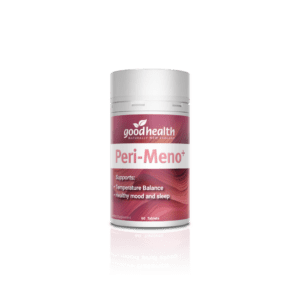
Để vinh danh sự ra mắt của Dòng sản phẩm Sức khỏe Phụ nữ, nhóm bác sĩ thiên nhiên Good Health đã biên soạn một loạt bài viết về sức khỏe đi sâu vào thế giới phức tạp, tuyệt vời của 3 giai đoạn M – dậy thì, kinh nguyệt và mãn kinh. Chúng tôi cũng sẽ khám phá vòng đời nội tiết tố và hệ vi sinh vật của phụ nữ, các vấn đề tiềm ẩn có thể phát sinh và một số mẹo của tổ tiên về cách hỗ trợ những gì đặc trưng của phụ nữ.

Đôi khi, việc trở thành phụ nữ giống như một trò đùa tàn khốc của vũ trụ - từ tuổi dậy thì đến thời kỳ mãn kinh, nhiều người trong chúng ta phải đối mặt với đau khổ về mặt cảm xúc và thể chất trong 1–2 tuần mỗi tháng, dường như ngày càng tệ hơn khi chúng ta già đi, và sau đó, khi tất cả những điều đó dừng lại ở thời kỳ mãn kinh, và chúng ta nghĩ rằng cuối cùng mình có thể thư giãn và thở, chúng ta lại phải chịu một loạt các gián đoạn liên tục có thể khiến thời kỳ tiền kinh nguyệt mỗi tháng trông giống như một chuyến đi ở Disneyland… mặc dù, là một trong những chuyến đi đáng sợ nhất! Để làm cho nó tệ hơn, phụ nữ thường bị các chuyên gia y tế đánh lừa hoặc chẩn đoán sai. Không nhất thiết phải như vậy, nhưng bạn cần phải kiểm soát sức khỏe của chính mình và có thể có rất nhiều điều chúng ta có thể học hỏi từ những người sống một lối sống nhất quán hơn về mặt tiến hóa về cách giữ cho hormone của chúng ta cân bằng và hoạt động tốt, ngay cả khi đã lớn tuổi.
Chào mừng đến với Phần 3—Thời kỳ mãn kinh…và tiền mãn kinh
Ở nhiều nền văn hóa, mãn kinh được coi là một món quà: khi phụ nữ trở thành “bà” thông thái, hỗ trợ và hướng dẫn trong khi được tự do tận hưởng những khía cạnh khác của cuộc sống, bao gồm sức sống, niềm vui và tình dục, mà không phải chịu trách nhiệm gì thêm cho việc mang thai. Thật không may, ở thế giới phát triển, với lối sống hiện đại, nhịp độ nhanh và chế độ ăn siêu chế biến, phụ nữ có thể thấy chất lượng cuộc sống của họ giảm sút khi họ bước vào thời kỳ tiền mãn kinh. Các triệu chứng mãn kinh—nhiệt độ dao động, ngủ kém, thay đổi tâm trạng, cứng khớp, tăng cân, sương mù não, v.v.—được biết là gây ra bệnh tật cho hơn 80% của phụ nữ phương Tây. Trong những năm sinh sản, ảnh hưởng của estrogen dẫn đến tích tụ mỡ ở ngực, hông và mông, trong khi tăng cân sau mãn kinh có thể ở vùng trung tâm và nội tạng (xung quanh các cơ quan), đặc biệt là nếu quá trình trao đổi chất bị rối loạn.
Mãn kinh là sự chấm dứt chu kỳ kinh nguyệt dễ thụ thai ở phụ nữ, nhưng có thể có một số năm khả năng sinh sản giảm xuống—tỷ lệ nang trứng biến mất tăng lên, buồng trứng co lại và sản lượng hormone buồng trứng giảm. Buồng trứng thường không biến mất hoàn toàn, nhưng tuyến thượng thận và mô mỡ đảm nhiệm việc nâng vật nặng, tạo ra phần lớn androgen và estrogen (chủ yếu dưới dạng oestrone—E1). Có bằng chứng cho thấy rằng các hormone sinh sản không nhất thiết phải giảm mạnh và rằng, với việc tập trung vào việc cung cấp cho cơ thể những gì nó cần để trở thành một động vật khỏe mạnh, chúng ta có thể duy trì sự cân bằng và hoạt động rất tốt của các hormone sinh sản.
Ở phương Tây, chúng ta cũng đang trải qua thời kỳ mãn kinh ở độ tuổi ngày càng trẻ hơn. Chúng ta được cho biết rằng các triệu chứng là điều bình thường và điều duy nhất chúng ta có thể làm về chúng là can thiệp bằng các hormone ngoại sinh (đến từ bên ngoài cơ thể), có thể đi kèm với các tác dụng phụ. Nhiều phụ nữ đang tìm kiếm các phương pháp thay thế hỗ trợ tự nhiên cho các vấn đề sinh sản, không nhận ra rằng những thay đổi đơn giản về chế độ ăn uống và lối sống có thể có tác động như thế nào.

Vấn đề về hormone sinh sản
Trong thực hành y học cổ truyền Trung Quốc, phụ nữ gặp bất kỳ vấn đề nào với bất kỳ phần nào của chu kỳ kinh nguyệt đều được coi là bất thường, rằng chu kỳ kinh nguyệt của phụ nữ nên đến và đi dễ dàng như mặt trời mọc và lặn, và mãn kinh chỉ đơn giản là sự chấm dứt kinh nguyệt. Sẽ không có hoặc có rất ít sương mù não, thay đổi tâm trạng, các vấn đề về khớp hoặc bất kỳ bệnh tật nào khác đi kèm với "sự thay đổi". Lưu ý quan trọng: Nếu có bất kỳ điều gì về chu kỳ, thời kỳ tiền mãn kinh hoặc mãn kinh khiến bạn lo lắng, hãy đến gặp chuyên gia chăm sóc sức khỏe.
Người ta cho rằng các "triệu chứng" mãn kinh như tàu lượn siêu tốc chỉ đơn thuần là do sự lên xuống tăng dần của các hormone nữ, đặc biệt là mức độ estrogen giảm; tuy nhiên, rõ ràng là sự trao đổi chất không bình thường, căng thẳng, thiếu hụt chất dinh dưỡng và progesterone thấp là những yếu tố chính. Những điều đó chắc chắn sẽ ảnh hưởng đến các cơ quan nội tạng điều chỉnh và hỗ trợ sức khỏe hormone. Sức khỏe tuyến giáp và gan đặc biệt quan trọng đối với sức khỏe hormone sinh sản.
Mặc dù cơ thể mãn kinh vẫn sản xuất estrogen, nhưng một số phụ nữ phương Tây có thể gặp phải tình trạng "cai" oestradiol, giống như cai thuốc lá đột ngột, vì cơ thể họ sản xuất ít hơn. Nhưng oestradiol thực sự chỉ cần thiết trong những năm sinh sản. Người ta cho rằng phụ nữ phương Tây tiếp xúc với mức oestrogen cao hơn trong những năm sinh sản do "sự thống trị của oestrogen". Nhiều người có mức progesterone thấp và quá trình chuyển hóa oestradiol thành 4-OHE1 và 16-OHE1 kém, có liên quan đến tổn thương não, mô vú, v.v. Và hầu hết đều tiếp xúc với xenoestrogen từ quần áo, bao bì và môi trường của chúng ta.
Nghiên cứu đã chỉ ra rằng có thể là do sự sụt giảm tương đối của progesterone khiến hầu hết phụ nữ tiền mãn kinh ở phương Tây trải qua một chuyến đi tàu lượn siêu tốc. Các nghiên cứu khác đã chứng minh rằng nồng độ hormone luteinizing (LH) và hormone kích thích nang trứng (FSH) cao trong thời kỳ mãn kinh là do các dây thần kinh điều hòa mất độ nhạy với nồng độ estradiol cao hơn mức tối ưu hoặc "sự thống trị của estrogen". Sự gia tăng hormone LH và/hoặc FSH có thể gây ra nhiều triệu chứng vật lý khó chịu mà nhiều phụ nữ trong thời kỳ tiền mãn kinh gặp phải. Ngoài ra, nồng độ prolactin cao bất thường, có thể do những nguyên nhân như căng thẳng, các vấn đề về gan hoặc tuyến giáp, nồng độ estrogen mô cao và rối loạn chức năng chuyển hóa, có thể gây ra một số biểu hiện mãn kinh được cho là do "không đủ estrogen".
Điều thú vị là sản xuất estrogen cũng tăng khi mức độ căng thẳng cao, thường là chúng ta không biết. Xét nghiệm máu trong thời kỳ tiền mãn kinh có thể không cho biết toàn bộ câu chuyện, vì nồng độ estrogen (estrone) trong các tế bào và mô có thể đủ, hoặc thậm chí dư thừa, mặc dù nồng độ oestradiol trong máu giảm đáng kể. Oestrone được sản xuất bởi enzyme aromatase trong nhiều mô trong cơ thể, bao gồm vú và nội mạc tử cung. Aromatase tăng theo tuổi tác. Một trong những công việc của progesterone là giúp các tế bào trong các mô này giải phóng oestrogen vào máu để gan chuyển hóa và sau đó bài tiết. Bằng chứng cho thấy rằng đối với nhiều người trong chúng ta, thời kỳ mãn kinh khó khăn có thể chỉ đơn giản là sự tiếp diễn của tình trạng thống trị của oestrogen và tỷ lệ oestrogen/progesterone không lành mạnh. Cùng với điều này, chức năng tuyến giáp và gan bị suy yếu mà nhiều phụ nữ phương Tây đã trải qua trong nhiều năm, đôi khi là nhiều thập kỷ trước. Quá trình lão hóa không lành mạnh và căng thẳng ở các cơ quan chuyển hóa, đặc biệt là gan, có thể chuyển hóa Oestrogen khỏi chất chuyển hóa tương đối "yếu và an toàn" là 2-hydroxy estrone (2-OHE1) thành 16-hydroxy estrone (16-OHE1) và 4-hydroxy estrone (4-OHE1). Hai chất chuyển hóa sau có liên quan chặt chẽ đến kết quả sức khỏe kém hơn.
Do quá trình trao đổi chất và chức năng của các cơ quan và tuyến khỏe mạnh hơn, tỷ lệ béo phì thấp đến bằng không, tiếp xúc với nhựa (xenoestrogen) thấp đến bằng không và mức độ căng thẳng thấp hơn, con người nguyên thủy khỏe mạnh có mức độ tiếp xúc với estrogen thấp hơn trong suốt cuộc đời sinh sản của họ và có khả năng ít bị teo buồng trứng hơn. Họ dường như vẫn có lượng hormone sinh sản lành mạnh sau thời kỳ mãn kinh, bao gồm cả progesterone cực kỳ quan trọng và thường bị bỏ qua, cộng với mức prolactin lành mạnh. Họ cũng vẫn có khả năng chuyển hóa estrogen thành 2-OHE1.
Căng thẳng là một vấn đề lớn đối với sự cân bằng hormone tiền mãn kinh vì khi chúng ta bị căng thẳng, cơ thể chúng ta không thể chuyển hóa estrogen và bài tiết chúng, cũng như nhiều người trong chúng ta không thể sản xuất đủ lượng testosterone và progesterone để cân bằng phương trình. Căng thẳng cũng có thể làm tăng nồng độ prolactin. Quá trình oxy hóa tràn lan, hoặc tiềm năng oxy hóa khử thấp, và nhịp sinh học không bình thường—chu kỳ sáng và tối tự nhiên hàng ngày được trung gian bởi cortisol và melatonin—đã được chứng minh trong nghiên cứu là ảnh hưởng xấu đến quá trình chuyển đổi mãn kinh. Chúng ta cần cortisol tăng và giảm trong ngày, nhưng lối sống hiện đại và căng thẳng quá mức của chúng ta có thể dẫn đến nồng độ cortisol tăng cao vào ban đêm hoặc nồng độ tăng và giảm không đúng thời điểm. Thật không may, cortisol tăng cao trong thời gian dài có liên quan đến sự gián đoạn trong quá trình trao đổi chất và cuối cùng là tăng cân.
Trong thời kỳ tiền mãn kinh, sản xuất progesterone có thể giảm quá nhiều và cortisol tăng lên mà không có progesterone giúp kiểm soát. Cũng có những lý do sinh lý khác khiến cortisol mãn kinh tăng nhẹ, nhưng nếu cortisol tăng QUÁ nhiều, nó có thể góp phần gây tăng cân, rối loạn nội tiết tố, các vấn đề về tim mạch và mất cân bằng lượng đường trong máu. Progesterone cũng ngăn ngừa estrogen sau mãn kinh gây ra các vấn đề, đặc biệt là ở mô vú, não hoặc tử cung. Câu trả lời có thể là duy trì mức progesterone ở mức lành mạnh và hiệu quả. Tiếp xúc với ánh sáng mặt trời và ngủ ngon sẽ giúp ích cho điều này, cũng như duy trì tuyến giáp và gan của bạn ở tình trạng tốt nhất và ăn nhiều protein và chất béo - hãy nghĩ đến protein và chất béo động vật, không quá nhiều protein thực vật và chắc chắn không có dầu thực vật để có sức khỏe hormone. Chất béo động vật chứa cholesterol, là tiền chất của tất cả các hormone sinh sản và cortisol. Thêm vào đó, những chất béo bị coi là không công bằng này chứa 4 loại vitamin tan trong chất béo là A, D3, E và K2 - rất cần thiết cho chức năng của hormone sinh sản.
Cuối cùng, đối với nhiều người trong chúng ta, mãn kinh có vẻ như là một vòng luẩn quẩn của rối loạn chuyển hóa, nội tạng và nội tiết tố. Lối sống hiện đại của chúng ta, với chế độ ăn nhiều thực phẩm siêu chế biến, căng thẳng cao độ và tiếp xúc với chất ô nhiễm và ánh sáng nhân tạo, đặc biệt là vào ban đêm, rất có thể là nguyên nhân gây ra tỷ lệ phụ nữ mắc các vấn đề mãn kinh ngày càng gia tăng. Xenoestrogen từ nhựa phổ biến trong cuộc sống của chúng ta đặc biệt có vấn đề.
Tiếp xúc quá nhiều với ánh sáng xanh, ô nhiễm hóa chất, không khí và nhựa; tiêu thụ rượu; béo phì trung tâm; viêm; đường tinh luyện và dầu hạt; thuốc men; thiếu hụt chất dinh dưỡng, v.v., tất cả đều đã được chứng minh trong nghiên cứu là nguyên nhân gây ra hoặc làm trầm trọng thêm các biến chứng chuyển hóa nghiêm trọng. Sức khỏe sinh sản và nội tiết tố, ngay cả sau thời kỳ mãn kinh, là một điệu nhảy tinh tế và bí ẩn giữa tất cả các hormone của chúng ta. Con người có khả năng thích nghi đáng kinh ngạc, nhưng có vẻ như lối sống hiện đại đã làm mất cân bằng quá nhiều theo hướng sai.
Trí tuệ của tổ tiên loài người
Có những con người “nguyên thủy” trên khắp thế giới, vẫn sống gần gũi với thiên nhiên, như họ đã làm trong nhiều ngàn năm, những người phụ nữ của họ không biểu hiện các triệu chứng tiền mãn kinh, cũng không tăng thêm mỡ cơ thể sau mãn kinh, hoặc trải qua sự suy giảm mạnh mẽ như vậy thành bệnh mãn tính. Người ta suy đoán rằng điều này là do họ có quá trình trao đổi chất và chức năng hormone khỏe mạnh do các thói quen lối sống nhất quán về mặt tiến hóa.

Các yếu tố chính có vẻ như là:
- chế độ ăn giàu dinh dưỡng, có nguồn gốc từ động vật và không có thực phẩm chế biến quá mức
- một hệ vi sinh vật khỏe mạnh và cân bằng
- sự kết nối sâu sắc với trái đất, thiên nhiên và với nhau
- mạng xã hội hỗ trợ
- mức độ hoạt động phù hợp
- ít hoặc không có ô nhiễm điện từ, nhựa, hóa chất hoặc không khí
- giảm căng thẳng tổng thể
- tận hưởng sự sáng tạo và học tập
- không có thuốc dược phẩm
- tiếp xúc hàng ngày với ánh sáng tự nhiên (ít hoặc không có ánh sáng nhân tạo – bóng đèn LED/huỳnh quang, màn hình, v.v.)
Các nghiên cứu khoa học đã chứng minh rằng những thói quen sống này hỗ trợ nhịp sinh học của con người, chức năng nội tiết tố cân bằng, giấc ngủ ngon, kiểm soát căng thẳng, tiềm năng oxy hóa khử (quá trình oxy hóa và khử lành mạnh) và hormone “cảm thấy thoải mái” cao tự nhiên.
Nếu bạn là phụ nữ ở bất kỳ giai đoạn tiền mãn kinh nào và bạn đang gặp phải tình trạng mất cân bằng hormone sinh sản ảnh hưởng đến chất lượng cuộc sống, bạn cũng có thể đọc thêm về những điều hỗ trợ mà bạn có thể thử, đây. Sử dụng lối sống truyền thống và các yếu tố chế độ ăn uống để hỗ trợ hormone và quá trình trao đổi chất, bạn có thể tìm ra cách duy trì sự nhiệt tình và niềm vui sống trong suốt những năm tiền mãn kinh và sau đó.
Các loại thảo mộc có lịch sử sử dụng lâu đời trong y học cổ truyền và có thể hỗ trợ tuyệt vời cho hormone nữ.
Giới thiệu: Sức khỏe tốt Peri-Meno+
Sức khỏe tốt Peri-Meno+ là một công thức toàn diện chứa các loại thảo mộc được nghiên cứu khoa học để hỗ trợ phụ nữ trong những năm tiền mãn kinh và mãn kinh. Hoa bia đã được chứng minh là hỗ trợ cân bằng nhiệt độ, tâm trạng, chức năng não và thư giãn ở phụ nữ mãn kinh. Rễ cây rắn đen được biết đến rộng rãi như một chất hỗ trợ cho tâm trạng khỏe mạnh và sự thoải mái về nhiệt độ bên trong, và cây hồ lô ba hỗ trợ cân bằng nội tiết tố trong thời kỳ mãn kinh. Ashwagandha và cây xô thơm được bổ sung để hỗ trợ tâm trạng, sức khỏe và chức năng não, quản lý căng thẳng và giấc ngủ phục hồi. Ashwagandha đã được chứng minh là hỗ trợ mức cortisol lành mạnh. Cả 5 loại thảo mộc đều được sử dụng theo truyền thống để hỗ trợ phụ nữ khi họ trải qua thời kỳ mãn kinh, nhưng chúng cũng đã được nghiên cứu về khả năng hỗ trợ cân nặng và tỷ lệ trao đổi chất khỏe mạnh, cũng như chức năng tim mạch và chống oxy hóa.

Peri-Meno+ hỗ trợ:
- Nhiệt độ thoải mái
- Quản lý tâm trạng và căng thẳng
- Giấc ngủ lành mạnh
- Cân bằng nội tiết tố
- Chức năng tim mạch và não
- Chuyển hóa lành mạnh, cân nặng và cân bằng lượng đường trong máu
Nhấp vào mục sau để biết thêm thông tin về Chuỗi bài viết về Sức khỏe Phụ nữ:
3M và chu kỳ nội tiết tố nữ, Phần 1 – Tuổi dậy thì
3Ms và Chu kỳ nội tiết tố nữ, Phần 2 – Kinh nguyệt
Trí tuệ tổ tiên cho sức khỏe nội tiết tố nữ, Phần 1
Trí tuệ tổ tiên cho sức khỏe nội tiết tố nữ, Phần 2
Số phê duyệt của TAPS: PP2522
